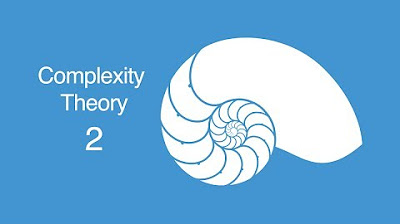Overview of General Systems Theory Recording #3
Summary
TLDRKelly Alvarado's PowerPoint presentation offers an insightful overview of General Systems Theory (GST), emphasizing its holistic approach to understanding interconnected systems. The presentation delves into the life and contributions of Ludwig von Bertalanffy, the theory's foundational concepts like open and closed systems, feedback loops, and dynamic equilibrium, and its application in higher education. It also addresses criticisms and explores how GST fosters interdisciplinary collaboration and shared governance in educational settings.
Takeaways
- 📚 General Systems Theory (GST) is a conceptual framework that emphasizes the interconnectedness and interdependence of all elements within a system.
- 🌟 Ludwig von Bertalanffy, the biologist and philosopher, is credited with developing GST, advocating for a holistic and interdisciplinary approach to understanding complex systems.
- 🔁 Open systems are a core concept of GST, characterized by their interaction with the environment, transformation of inputs into outputs, and the use of feedback loops for self-regulation.
- 🔄 Closed systems, in contrast to open systems, are self-contained and do not exchange matter or energy with their environment, focusing solely on internal processes.
- 🔁 Feedback loops are essential in GST, with negative feedback aiming to correct deviations and maintain stability, while positive feedback amplifies changes leading to growth or decline.
- 🔗 Interdependence and relationships are key in GST, highlighting the need for communication and coordination among subsystems to achieve common goals.
- 🌱 Dynamic equilibrium and homeostasis are states where a system maintains stability or a balance between variables despite ongoing changes.
- ⚠️ Criticisms of GST include the challenge of achieving true interdependence among personnel and the influence of external environmental factors on system structure and function.
- 🏫 Applications of GST in higher education include the instructor-centered versus learning-centered paradigms, promoting holistic learning and interdisciplinary collaboration.
- 🤝 The concept of shared governance in community colleges can be enhanced by adopting an open systems framework, encouraging subsystems to work together towards educational goals.
- 📧 The presentation concludes with an invitation for questions and further discussion, emphasizing the importance of ongoing dialogue in the application of GST.
Q & A
What is the main goal of the PowerPoint presentation by Kelly Alvarado?
-The main goal of the presentation is to help the audience understand the conceptual theory of General Systems Theory (GST), the author and his major contributions, and the application of the theory in today's world within higher education.
What is the key concept of General Systems Theory according to the quote in the presentation?
-The key concept is the interrelatedness of nature and the universe, emphasizing the interconnectedness of all things, which is central to the understanding of open systems in GST.
Who is Ludwig von Bertalanffy and what was his profession?
-Ludwig von Bertalanffy was a biologist, born on September 19, 1901, in Austria-Hungary, and he passed away on June 12, 1972, in Buffalo, New York. He believed in a holistic view of the world and the interdisciplinary thought of science.
What is the difference between open and closed systems in General Systems Theory?
-Open systems are influenced by the environment and transform inputs into outputs with the help of feedback loops. Closed systems, on the other hand, are self-perpetuating and do not receive outside energy or resources, focusing only on internal functions without considering environmental factors.
What are the two types of feedback loops mentioned in the presentation?
-The two types of feedback loops are negative feedback, which provides corrective action when things are not going well, and positive feedback, which amplifies the initial disturbance to improve outcomes.
How does the concept of interdependence in relationships relate to higher education according to General Systems Theory?
-Interdependence in relationships suggests that various departments and programs within higher education are interrelated subsystems that work together to achieve a common goal, requiring communication plans for the exchange of relevant information.
What is dynamic equilibrium and how can it be seen in higher education?
-Dynamic equilibrium exists when system components are in a state of change, but at least one variable stays within a specified range. In higher education, this can be seen in retention rates, where various departments work together to keep the rate within a certain range.
What is homeostasis and how is it related to higher education?
-Homeostasis is a condition of dynamic equilibrium between at least two system variables. In the context of higher education, it can refer to variables like retention and graduation rates, which are kept within a specific range by the coordinated efforts of various departments.
What are some criticisms of General Systems Theory mentioned in the presentation?
-Criticisms include the interdependence of personnel, which requires individuals to work together across disciplines, the effect of the environment on structure and function, and the challenge of nature versus nurture within an organization.
Can you provide an example of how General Systems Theory is applied in higher education?
-An example is the use of an interdisciplinary approach, such as a math and English class team-taught by a mathematician and an English faculty, which helps reduce department silos and extends resources for a more holistic learning experience.
What is the discussion board question posed in the presentation regarding higher education and open systems?
-The question asks how community college leaders can create an environment of shared governance using an open systems framework and whether subsystems can work interrelatedly towards a similar goal in higher education.
Outlines

このセクションは有料ユーザー限定です。 アクセスするには、アップグレードをお願いします。
今すぐアップグレードMindmap

このセクションは有料ユーザー限定です。 アクセスするには、アップグレードをお願いします。
今すぐアップグレードKeywords

このセクションは有料ユーザー限定です。 アクセスするには、アップグレードをお願いします。
今すぐアップグレードHighlights

このセクションは有料ユーザー限定です。 アクセスするには、アップグレードをお願いします。
今すぐアップグレードTranscripts

このセクションは有料ユーザー限定です。 アクセスするには、アップグレードをお願いします。
今すぐアップグレード5.0 / 5 (0 votes)






